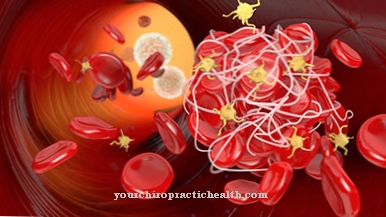A Hydrocyanic acid poisoning is poisoning caused by contact with hydrocyanic acid (cyanide), which can be fatal even if small amounts are ingested.
What is prussic acid poisoning?

© RRF - stock.adobe.com
Oral ingestion of 70 mg of hydrocyanic acid-containing substances can lead to death from hydrocyanic acid poisoning. A fatal effect is sometimes assumed from an intake of 1 to 2 mg hydrogen cyanide per kilo of body weight.
Hydrocyanic acid is found in the kernels of some fruits. Hydrocyanic acid also develops when plastics are burned in a house or car, for example. But hydrogen cyanide poisoning can also occur more than average in the electroplating industry. There were also cases of hydrocyanic acid poisoning with medically indicated infusion of the drug nitropusside, which belongs to the cyanides.
About a third of all people cannot perceive the odor of bitter almonds emitted by hydrogen cyanide due to hereditary factors. Food and substances that may contain cyanide must therefore be handled very carefully because of the risk of hydrocyanic acid poisoning.
causes
Hydrocyanic acid poisoning can be triggered by skin contact, ingestion or inhalation. The poisoning is caused by hydrogen cyanide, which blocks cell respiration and thus causes "internal suffocation".
Hydrocyanic acid can enter the blood and surrounding tissue areas through the breath via the lungs (for example after gas formation in smoldering fires). Since hydrocyanic acid evaporates quickly at normal room temperatures, cyanides are quickly released into the air.
Hydrocyanic acid can also penetrate the upper layers of the skin without difficulty and thus enter the bloodstream. The absorption of prussic acid through the skin is favored during sweat-producing physical activity, as prussic acid is very soluble in water.
Likewise, cyanide enters the bloodstream when foods containing hydrocyanic acid are consumed, causing hydrocyanic acid poisoning.
Symptoms, ailments & signs
When hydrogen cyanide poisoning is mentioned, acutely severe and always fatal poisoning is usually thought of. This is also the case when inhaling large amounts of hydrogen cyanide. In these cases there is severe shortness of breath, cramps, vomiting and loss of consciousness. The breath of the poisoned has a typical bitter almond odor.
Death from asphyxiation occurs within seconds or minutes. Hydrocyanic acid poisoning can subsequently be recognized by the light red color of the dead skin. The corpse marks appear bright red. With less strong concentrations of hydrogen cyanide, rapid treatment with cyanide-binding or cyanide-degrading substances can save life.
What is less well known, however, is that there is also acute non-fatal hydrocyanic acid poisoning. There is little information on this in the medical literature. But even in these cases, the poisoning initially manifests itself in the form of shortness of breath, severe headache, dizziness, cramps, vomiting and possibly unconsciousness. After the end of the acute phase, however, neurological symptoms can appear.
In individual cases, speech disorders, memory impairment, lack of energy, severe fatigue, disorientation and general physical and mental decline occur. These disorders are very protracted and can last forever, as the central nervous system and brain are often irreversibly damaged. However, it has also been found that other organs are usually not affected.
Diagnosis & course
The patient suffering from hydrogen cyanide poisoning suffers from dizziness, vomiting, headache and ringing in the ears. A typical symptom of hydrogen cyanide poisoning is the patient's breath smelling of bitter almonds.
The hyperventilating patient becomes short of breath. In severe cases of intoxication, epileptic seizures occur. The patient loses consciousness (on average after 26 minutes) and eventually suffers respiratory paralysis. If no treatment is given, a high dose of poison will result in death within a very short time after ingestion of the toxins.
As the oxygen can no longer be processed by the body and therefore remains in the veins, the blood appears bright red, so that the mucous membranes and the skin of the sick person show a pink color. After a death from hydrocyanic acid poisoning, typical, bright red corpse marks (livores) similar to poisoning by carbon monoxide appear.
A reliable diagnosis can usually only be made with the help of information from relatives or third parties (external anamnesis), since the person affected is usually no longer able to provide relevant information in the case of hydrogen cyanide poisoning.
Complications
Hydrocyanic acid poisoning is a very serious poisoning of the human body and must be treated by a doctor. If the prussic acid poisoning is not treated in time, the patient can suffer permanent damage. In the worst case, hydrocyanic acid poisoning leads to death.
After hydrocyanic acid poisoning, the affected person usually first suffers from severe shortness of breath. In addition to this shortness of breath, there is the typical smell of bitter almonds that comes out of the patient's breath. Headaches, dizziness, vomiting, fainting spells and cramps also occur. The skin color often turns rosy.
If the skin slowly turns pink or light red, an emergency doctor must be called urgently, as this will result in death. In the case of hydrogen cyanide poisoning with a relatively high concentration, however, the red color does not appear. If the hydrogen cyanide has been inhaled, it comes to respiratory arrest and cardiac arrest after only a few minutes.
In this case, treatment is no longer possible. In the case of minor hydrocyanic acid poisoning, treatment with sulfur takes place, which is also added to the body. If only a small amount of hydrogen cyanide has been absorbed, there is a relatively high chance that the patient will recover. Higher amounts are less likely. The lethal dose for humans is 100 molecules of cyanide per million air molecules.
When should you go to the doctor?
In the event of cyanide poisoning, medical help should be sought immediately. This also applies if the amount of the toxin absorbed is only very small. Particular care should be taken with children and pets, who often poison themselves through fruit or raw legumes.
Hydrocyanic acid is not only found in the notorious bitter almonds. The kernels of cherries and apples as well as the stones of plums, apricots and peaches also contain hydric acid. If there is a risk that a child or a pet has swallowed such fruit components or has eaten raw beans or raw peas straight from the bush, a doctor or veterinarian should be consulted immediately as a precaution. A doctor should also be consulted for elderly people and people in poor general condition in order to prevent complications and long-term effects.
Healthy adults should seek medical help at the latest when a dangerous amount of hydrogen cyanide has been consumed or the first symptoms of poisoning appear. The lethal dose in humans is around one gram per kilogram of body weight. However, even lower doses must be treated promptly.
If the first symptoms of hydrocyanic acid poisoning appear, a doctor must be consulted immediately. Those affected initially suffer from nausea and vomiting, often followed by severe headaches and cramps. As soon as the patient shows a rosy skin color, there is an acute danger to life from carbon monoxide poisoning. In this case, the emergency doctor must be notified immediately.
Doctors & therapists in your area
Treatment & Therapy
If there is any fear of hydrocyanic acid poisoning, a doctor must be consulted immediately. The extent of the poisoning depends on whether the supply of fresh air is sufficient, whether a breathing mask is to be used for ventilation or whether oxygen ventilation must be carried out under positive pressure.
Ventilation is then provided by 100 percent oxygen by inserting a tube into the respiratory organs. In order to exclude organ damage, this treatment is carried out even if the sick person should be able to speak again in the meantime.
On the other hand, mouth-to-nose or mouth-to-mouth resuscitation must never be used, as the helper would otherwise expose himself to the risk of hydrocyanic acid poisoning.
As an antidote, a so-called antidote, especially sodium thiosulphate, 4-DMAP (4-dimethylaminophenol) or hydroxocobalamin, is administered to the patient as an antidote in order to convert the hydrocyanic acid into less dangerous thiocyanate, which can no longer lead to respiratory paralysis. With only minor symptoms of intoxication, z. B. the administration of 1 to 3.25 mg of 4-DMAP per kilogram of body weight and then the gradual administration of 10 grams of sodium thiosulfate.
If the patient has consumed large amounts of bitter almonds or if the poison has been ingested in another way, gastric lavage is carried out. In order to remove the hydrocyanic acid compounds from the body as quickly as possible, laxatives and large-pored activated charcoal are used, which are able to bind cyanides.
Outlook & forecast
The prognosis for hydrocyanic acid poisoning is generally poor. The only form of cyanide poisoning that can be survived without treatment is that of very mild poisoning, which manifests itself in weak symptoms. Such a very slight poisoning can also be overcome by the person concerned, since the body is able to break down the hydrogen cyanide in small amounts. In such cases, however, the general malaise is hardly perceived as poisoning.
In the case of moderate and severe poisoning, on the other hand, without treatment, death inevitably occurs from respiratory or cardiac arrest. Moderately severe poisoning can be combated in those affected by immediate emergency measures that must be initiated minutes after the symptoms of poisoning appear. The chances of surviving this without any consequential damage are good with immediate help and detoxification.
The limit is often given here as 30 minutes. Severe cyanide poisoning, for example through direct inhalation, will, however, be fatal even in the case of relief measures. If the lethal dose is reached or exceeded, detoxification measures no longer help. After all, poisoning leads to death within minutes.
Consequential damage only occurs when internal organs have been damaged as a result of the poisoning. This is not necessarily the case and depends, among other things, on how the cyanide was absorbed.
prevention
Since cyanide poisoning has to be treated very quickly, all cyanide processing companies, ambulances and clinics must be equipped with sufficient amounts of antidote at all times in order to be able to administer the antidotes at the latest 30 minutes after poisoning.
Basically, you should be careful with foods containing hydric acid such as bitter almonds. In the event of smoldering or car fires, all persons must be removed from the smoke zone as quickly as possible.
Aftercare
A deliberately induced hydrocyanic acid poisoning often relieves the treating physicians from follow-up care. It is usually fatal. However, people often experience accidental hydrocyanic acid poisoning. Eating bitter almonds or bitter apricot kernels can cause slight symptoms of poisoning.
Hydrocyanic acid poisoning can also result from inhaled smoke from burning plastics or from work in the electroplating industry. It becomes dangerous because many people cannot perceive the typical smell of hydrogen cyanide.
Medical treatment is necessary in the event of symptoms of poisoning. Since it is an acute poisoning, neurological damage is possible. These are subject to medical follow-up care. As part of comprehensive preventive measures, pregnant women should refrain from anything that prevents the unborn child from being poisoned with small amounts of hydrogen cyanide from foods containing cyanide.
Cancer patients who take amygdalin as a dietary supplement occasionally suffer from prussic acid poisoning. This leads to a hospital stay and oncological follow-up measures. As part of cancer therapy, amygdalin is often offered abroad as "vitamin B17". However, this preparation is banned in Germany.
The same applies to the chemically similarly structured Laetrile. Anyone who illegally procures amygdalin to supplement cancer therapy is at risk. The remodeling of the active ingredient in the intestines causes hydrogen cyanide poisoning. Follow-up care after hydrocyanic acid poisoning depends on the degree of the symptoms of poisoning and the resulting damage.
You can do that yourself
If you suspect hydrogen cyanide poisoning, first aid measures must be taken. The person concerned must be taken out of the danger area immediately and supplied with fresh air. If the patient has stopped breathing, resuscitation must be carried out immediately using cardiopulmonary resuscitation. Mouth-to-mouth resuscitation should be avoided due to the acute risk of poisoning.
Until the rescue service arrives, the person affected should be placed on their side and, if possible, wrapped in a warm blanket. Restricting clothing must be opened or loosened. The emergency doctor must be informed about the cause of the poisoning and the condition of the poisoned on the basis of the W questions in order to enable targeted treatment. Finally, the cause of the poisoning should be determined and eliminated as soon as possible, provided that this is possible without further risk of poisoning.
After the hydrocyanic acid poisoning has been cured, the affected person may have to take dietary measures to compensate for lost nutrients and fluids (through gastric lavage). Bed rest and rest are also recommended. Since contact with the poisoned person can lead to poisoning, first aiders should also be examined by an emergency doctor.

























.jpg)

.jpg)
